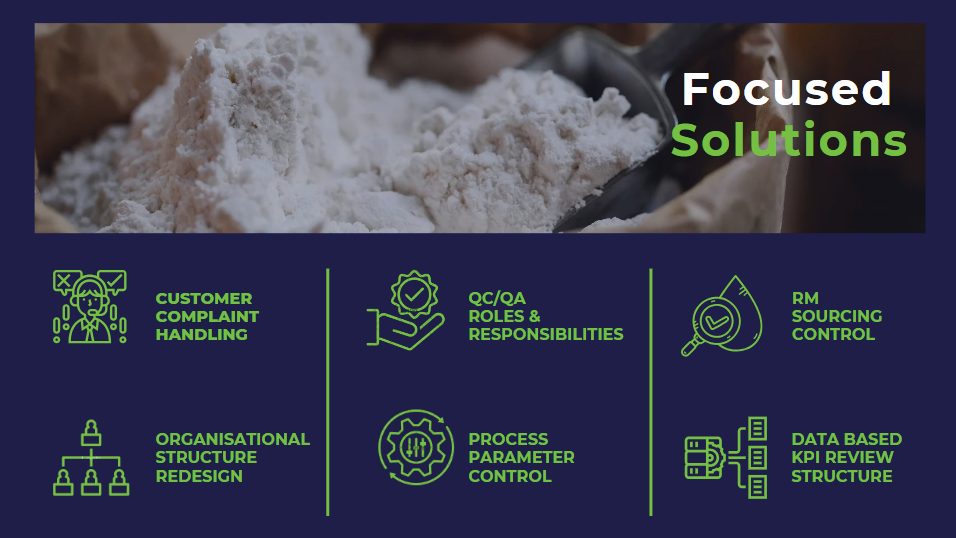Background
Our client started as a flour milling company in Asia in the 1960s. Over the past 60 years, it has grown into a diversified business with divisions serving the minerals, energy, property, logistics, retail, detergents, and food industries.
Sales of its core product, flour, are structured through five channels: retail, bulk, institutions, export, and government. They sell their flour products to a wide range of customers, including bakeries, hotels, and for home consumption.
Project genesis
Its food division had received a significant number of quality complaints from customers. Despite internal efforts to address these complaints, the problem persisted. The company’s internal quality structure exacerbated the problem, with overlapping roles between departments and a lack of clarity among employees about their responsibilities.
Renoir was initially engaged to assist with an analysis to better understand the issues and develop a way forward. During a two-week analysis through surveys and discussions with distributors and retailers, we identified complaints specific to white wheat flour.
Based on the findings of the analysis, we felt that a reduction in customer complaints could be achieved through the implementation of a fit-for-purpose Quality Management Control System (MCS).
Other deliverables that would complement the project included process control charts, responsibility assignment matrix (RACI) charts, standard definitions and internalisation of root cause analysis.
Project Approach
After the two-week analysis, Renoir was invited to undertake a 24-week change project to facilitate improvements in the working practices of the production and quality control/quality assurance departments.
A full-time project team was set up, consisting of a consultant and a project manager from Renoir, together with a full-time employee from the client’s office. A part-time Management Action Team (MAT) was set up to drive the project’s objectives on a day-to-day basis and ensure that the solutions were implemented.
The project followed Renoir’s Focus Process®, with the MAT validating the findings, proposed solutions, and implementation plan using the elements of the Quality Excellence System.
Daily and weekly reviews were initiated by the quality team as part of the MCS. Digital Key Performance Indicator (KPI) dashboards were designed and implemented to ensure that performance was measured and communicated, allowing any course corrections to be made at shorter intervals.
Ready for a change in your organisation?
Implementation
The implementation of the Quality Excellence System was divided into three phases: Focus Process, Installation and Sustainability.
The Renoir Focus Process
The project began with the identification of key gaps by mapping the existing Quality Management Control System and having it critiqued by key stakeholders.
At the same time, the team also mapped various processes including raw material purchasing, raw material quality control, in-process quality control, finished goods quality control and customer complaint handling process.
Based on the findings, the team developed changes to the company’s existing Quality Excellence System that could address the key gaps identified. The changes focused on the organisational elements shown here:
This phase concluded with the Strategic Integration Meeting (SIM), chaired by the Board members and attended by the MAT Chairman and the project team. During this meeting, the management team agreed and approved the project’s measures of success: KPIs and areas for improvement.
Installation
This phase began with classroom and on-site coaching sessions for stakeholders. Six high-level elements of the Quality Excellence System were set up for the company (see figure above).
Sustainability
After three weeks of initial handholding with stakeholders, we began behavioural audits to determine the user compliance, understanding and usage of the new system. The audits were conducted on a daily and weekly basis and regular audit reviews were initiated to further strengthen the adoption of the system.
Results
Key results:
Customer complaints reduced by 60%
Return costs reduced by 65%
At the end of the 24-week period, the MCS set up to track, measure and improve internal complaints showed a consistent increase in resolution to 90% or more.
The team also achieved system usage of 40%, demonstrating a positive change journey. System usage is a good indicator of the users’ independence in using and driving change to the system, which fosters sustainability beyond the end of the project.
At the end of the project, the client benefitted significantly from both financial and non-financial outcomes. They made significant progress in addressing quality challenges. Their employees also established a culture of continuous improvement.
*We have intentionally omitted client-specific details to uphold strict confidentiality.
How can you improve your business processes for better customer-centricity and satisfaction?













